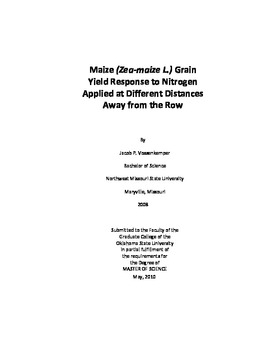| dc.description.abstract | A one percent global increase in nitrogen use efficiency would be worth approximately 1 billion dollars (Raun and Johnson, 1999). It is thus important to apply nitrogen (N) midseason or split applied so as to improve nitrogen use efficiency (NUE) (Tubaa et al., 2008). Also, applying N closer to the plant could improve NUE. This new placement approach may be important in semi-arid to arid climates where mass flow of nitrogen is hindered by low soil moisture. Experimental sites were established at the R.L. Westerman Irrigation Research Station near Stillwater, OK in the spring of 2008 and 2009. In the spring of 2009, one more location was added near Haskell, OK. The R.L. Westerman Irrigation Research Station is located on a Port-Oscar silt loam (fine-silty, mixed, super active, thermic Cumulic Haplustolls), and the site near Haskell, OK (dry-land) is located on a Taloka silt loam (Fine, mixed, active, thermic Mollic Albaqualfs). Traditionally midseason fertilizer applications in corn (Zea maize L.) are placed down the center of 76 cm rows, making the distance of application 38 cm from the plant. This study evaluates midseason (V8 to V10) liquid urea ammonium nitrate (UAN) rates (45, 90, 134, and 224 kg N ha-1) applied at different distances (0, 10, 20, 30 and 38 cmwithin the row; as well as specifically applying UAN (28%) directly to the plant stalk 13 cm vertically from the soil surface along a horizontal plane. The findings suggest that placing midseason application (V8 to V10) of UAN (28%) closer to the plant can increase corn grain yields. Furthermore corn grain yields were highest when midseason applications were placed at the base of the plant (0 cm) and at the 10 cm application distances. These results suggest that if producers are going to apply mid-season N, they need to apply it closer to the row and avoid applying N in the middle of the row which is currently the most commonly accepted practice In corn production. | |
